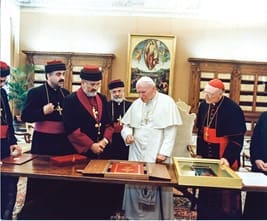Barbaric describes best the ferocity unleashed in Iraq and Syria. Ironically, these “nation states” largely correspond to the lands of ancient Mesopotamia — the cradle of civilization. There, thousands of years before the birth of Christ, the world’s first complex human societies emerged between the Tigris and Euphrates rivers.
It is less commonly known that Mesopotamia is also the cradle of the Christian faith. In its fertile soil, the seeds of Christianity took root quickly and eventually spread like wildflowers throughout Asia, reaching Afghanistan, China, India and Mongolia. But the Church of the East, the driving force behind the missionaries took the Gospel east via the Silk Road, has all but vanished. While a handful of the church’s members — who identify as Assyrians — remain in Mesopotamia, more than a third live in North America. The headquarters for the church of 400,000 people has been moved to a Chicago suburb, but increasingly its members are settling in Oceania and Scandinavia.
The origins of the Christian faith in Mesopotamia are obscure. An ancient legend connects a sickly king of Edessa to Jesus. Others credit St. Thomas the Apostle with evangelizing the region’s Jewish merchants as he traveled to India. That Edessa is the likely source of the faith in Mesopotamia is supported by linguistic evidence: The Aramaic dialect of Edessa, commonly called Syriac, became the literary language of the non-Greek-speaking Christian community in the Middle East.
Syriac Christianity flourished in a divided Mesopotamia. While Syriac Christians living in Byzantine-occupied territories participated in the great debates of the early church, Syriac Christians living in Persian areas developed independently. By the year 410, the Syriac bishop of the Persian capital (near modern Baghdad) emerged as the senior hierarch of the Persian church.

Commonly referred to as the Church of the East, this community retained its ties to the churches of Rome, Constantinople, Alexandria, Antioch and Jerusalem. Yet, it grew under the suspicious eyes of the Persians — followers of the prophet Zoroaster — who suspected Christians of harboring loyalties to Christian Byzantium. By the end of the fifth century, as war raged between Byzantium and Persia, the Church of the East severed union with its sister churches in the Christian West.
Nevertheless, the Church of the East became renowned throughout the Christian world for its scholarship, especially in grammar, history, logic, mathematics, philosophy and theology. Arab Muslims, who conquered the Persian Empire in 634, turned to its scholars, who are largely responsible for the Arab world’s familiarity with ancient Greek astronomy, chemistry, mathematics and philosophy — disciplines that eventually reached Europe via Arab Sicily and Spain.
At its height in the 14th century, the Church of the East spanned most of Asia and included some 30 metropolitan sees and more than 200 eparchies. But the church’s successes were nearly destroyed overnight. Although the Crusades upset the Middle East’s carefully balanced Middle East societies, the near deathblow came from the east. At the end of the 14th century, Timur the Lame and his army invaded the Middle East, sacked its cities, massacred the inhabitants and leveled what remained. Those Christians who escaped death or enslavement retreated into the mountains, hunkering down in remote monasteries and mountainside villages. Isolation intensified, poverty set in and generation after generation either abjured their Christian faith and embraced Islam or became Catholics as contact with Latin missionaries increased.
During World War I, up to a third of those who belonged to the Church of the East were murdered by agents of the Ottoman Turkish sultan, which governed most of Mesopotamia. Survivors fled to the British-held cities of Mosul, Baghdad and Basra — and points farther west.
War and emigration have nearly decimated the presence of the church in the cradle of civilization. Yet, the sufferings of the Church of the East have brought to light not just the existence of this ancient community, but the richness of a tradition that unknowingly influenced the cultures and churches of the West.
Read here a full account of the Church of the East from the pages of ONE magazine.